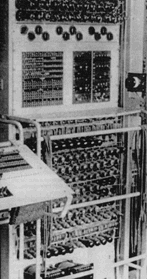Computers
Computers play a very important part in our lives now and as with so many recent inventions, no one person can claim to have sole responsibility for their invention.
However, one man is credited with having the vision to see that one day a general-purpose computing machine would exist. This man was Charles Babbage and he first floated his idea in 1834 !! Five years after he died in 1871, Lord Kelvin, a Scottish physicist, also raised the idea of building a machine that could cope with general problems. But many years were to pass before a machine was produced which was capable of doing what Babbage and Kelvin wanted.
In 1930, MIT (the Massachusetts Institute of Technology) built a “differential analyser”. The team that did this was lead by Vannevar Bush. This machine could solve differential equations that came up in electrical engineering – but it was so big that it filled a whole room.
The major breakthrough in computing came when scientists started to use the binary system in electrical devices. Binary allows every number to be expressed as a series of ones or zeros and electrical devices see binary numbers as being “on” or “off”.
In 1938, a German mathematician, Konrad Zuse, invented Z1. This machine had a binary-based operating method, a processor unit and memory and for this reason some historians see Z1 as being the first computer. Z1 lead to Z2 and Z3. The last one is considered to be the world’s first programmable calculator. World War Two interrupted the work done by Zuse.
In America, Howard Aitkins and his team at Harvard University, completed Mark 1 in 1943. This 5 tons machine could perform basic mathematical functions. It also attracted the attention of International Business Machines (IBM). This invention occurred during a very important era for computer development : World War Two.
During this war, Britain wanted to develop a computing machine that would break the secret codes used by the Nazis. Some of the country’s most brilliant mathematicians were based at Bletchley Park, including the outstanding Alan Turing. Even before the war, Turing had attempted to develop a machine capable of performing all the operations of mathematics. Such a machine would have been able to crack even the most difficult of secret codes.
By December 1943, a new device was invented at Bletchley Park called “Colossus“. It was not a true computer but it did show that machines could do a lot more than handle numerical problems.

Colossus at Bletchley Park
In America during World War Two, Presper Eckhart and John Mauchly invented ENIAC (Electronic Numerical Integrator Analyser and Computer). This vast machine – it weighed 30 tonnes – was finished in November 1945 and contained 18,000 valves. It could work 1000 times faster than any of its predecessors. It was basically just a calculator but it did prove to scientists that a lot of valves put together could work effectively.
Some historians believe that the first true computer was developed by a team at Manchester University lead by Dr Freddie Williams. Their invention was commercially produced by the firm Ferranti and was known as Ferranti Mark 1. This was in 1951.
America also produced its first commercial computer in 1951 called UNIVAC; its first important use was to predict the outcome of the US Presidential election race in 1952.